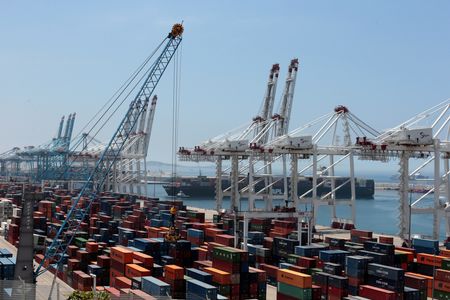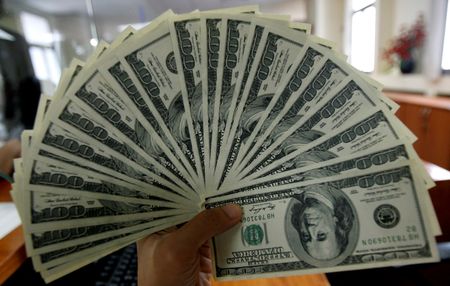By Rae Wee
SINGAPORE (Reuters) – The dollar barely recouped its heavy losses on Tuesday as investors were no clearer on whether a de-escalation of the Sino-U.S. trade war was underway, with Treasury Secretary Scott Bessent suggesting the onus was on China to start negotiations.
Bessent said in an interview on Monday that it was up to China to de-escalate on tariffs – the latest in a slew of conflicting signals over progress on trade talks between the world’s two largest economies.
While U.S. President Donald Trump insists there has been progress and that he has spoken with Chinese President Xi Jinping, Beijing has denied such assertions.
The confusion just gave investors more reason to sell the dollar and it fell sharply against the safe-haven yen and Swiss franc in the previous session.
The U.S. currency struggled to regain lost ground on Tuesday, though it did eke out a 0.48% gain against the Swiss franc to last stand at 0.8238, and rose 0.27% to 142.41 yen.
Trading was thinned with Japan out for a holiday.
Sentiment was helped slightly by news that U.S. President Donald Trump’s administration will move to reduce the impact of his automotive tariffs on Tuesday.
“Given the conflicting signals, I think a deal is very unlikely in the near-term and China might be preparing for a protracted trade war,” said Carol Kong, a currency strategist at Commonwealth Bank of Australia (CBA).
“Overall, the U.S. tariff policy is very chaotic and markets definitely don’t like that, but there is indeed some growing optimism that the worst of the trade war is over.”
Despite little evidence of progress being made in trade negotiations between the United States and China, both sides in recent days seemed to have softened their respective stances, with the Trump administration signalling openness to reducing tariffs and China exempting some U.S. imports from its 125% levies.
The euro was down 0.34% at $1.1383, but remained on track for its largest monthly gain against the dollar in more than two years as investors flee U.S. assets and search for alternatives in Europe.
Sterling hovered near a three-year top at $1.3399. Against a basket of currencies, the dollar steadied at 99.25, having fallen 0.6% in the previous session.
Still, the dollar index was headed for its worst monthly fall since November 2022 at 4.7%.
In Canada, the loonie fell more than 0.2% to C$1.3863, after Prime Minister Mark Carney’s Liberals retained power in the country’s election on Monday, but fell short of the majority government he had wanted to help him negotiate tariffs with Trump.
“If there’s two things investors don’t like, it’s uncertainty and minority governments. Investors now have both,” said Matt Simpson, senior market analyst at City Index.
“With legislation likely harder to pass, it could mean trade negotiations are to be less smooth. And not that they were ever likely to be smooth to begin with.”
Investors were also bracing for a week packed with U.S. economic data, which may provide some early indication on whether Trump’s trade war is hitting home.
Friday’s jobs report will be key for markets, with preliminary first-quarter growth figures and core PCE data – the Federal Reserve’s favoured inflation gauge – due ahead of that.
“I think U.S. economic data will definitely deteriorate further from here,” said CBA’s Kong.
“When the weak hard data comes out, I think it will further weigh on the U.S. dollar, because for the time being, I think investors are seeing the U.S. dollar as a less reliable safe-haven currency. In fact, I think (it’s) trading more like a risk currency.”
Elsewhere, the Australian dollar rose to an over four-month top of $0.6450, before paring some of those gains to trade 0.27% lower at $0.6415.
The New Zealand dollar fell 0.47% to $0.5952. (This story has been corrected to fix the milestone for euro’s monthly gain to most in more than two years, not in nearly 15 years, in paragraph 11)
(Reporting by Rae Wee; Editing by Shri Navaratnam and Kim Coghill)











